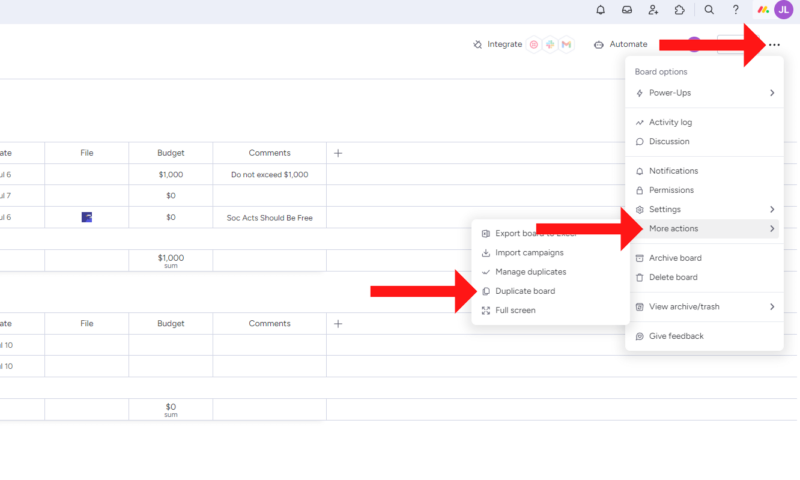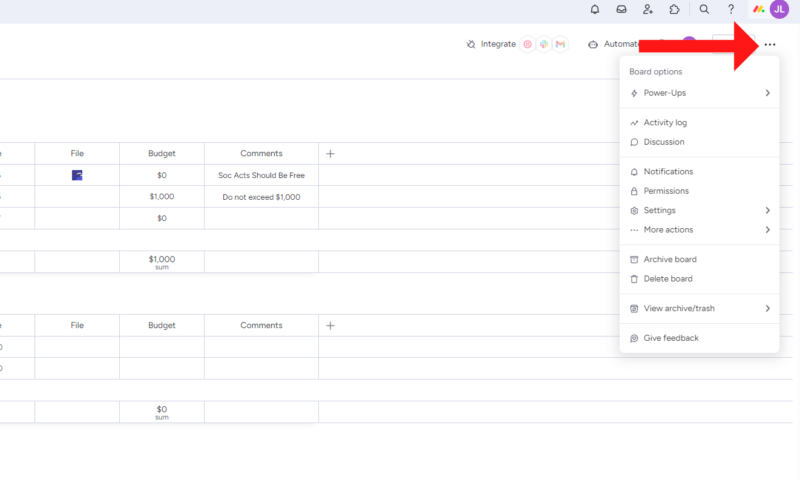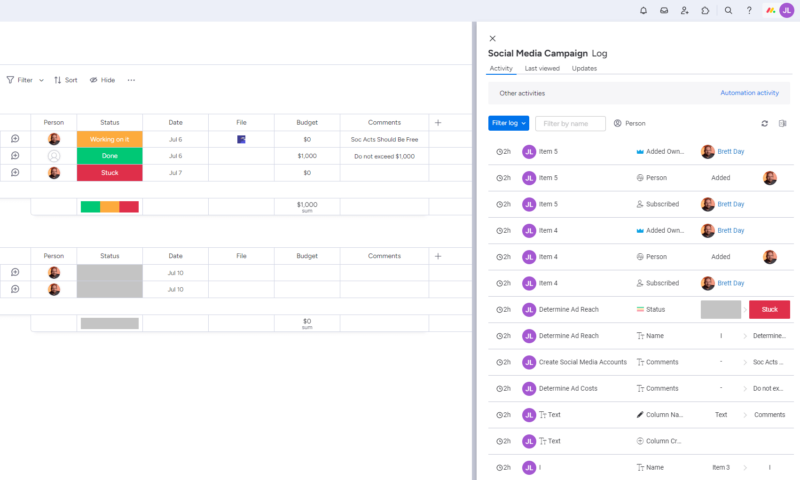monday.com tops our roundup of the best project management software for many reasons, including its ease of use, knowledge centers and numerous tools. The collaborative boards are one of its most powerful tools that allow team members to stay up-to-date on tasks and other project processes. If you don’t know how to use a monday board, read on.
In this guide, we’ll tell you what monday boards are and explain how they differ from dashboards. You’ll also see how to create, configure, share and export boards to other software like Excel. If you want to learn more about monday.com in general, check out our monday.com review. Now, let’s jump into what monday boards are and see what they can do for you.
What Is a monday.com Board?
On monday.com, a board is a central hub that allows teams to assign tasks, as well as track and manage everyday processes found in simple and complex workflows. Boards are interactive and collaborative, so team members can see what’s happening in real time.
monday.com Board vs Dashboard
A monday.com board is an interactive, cooperative tool for tracking and managing workflows, day-to-day tasks and other processes such as time management, risk management and registries for stakeholder analysis. A dashboard is a customizable hub that can display multiple project metrics, including performance indicators, calendars, Gantt charts and more.
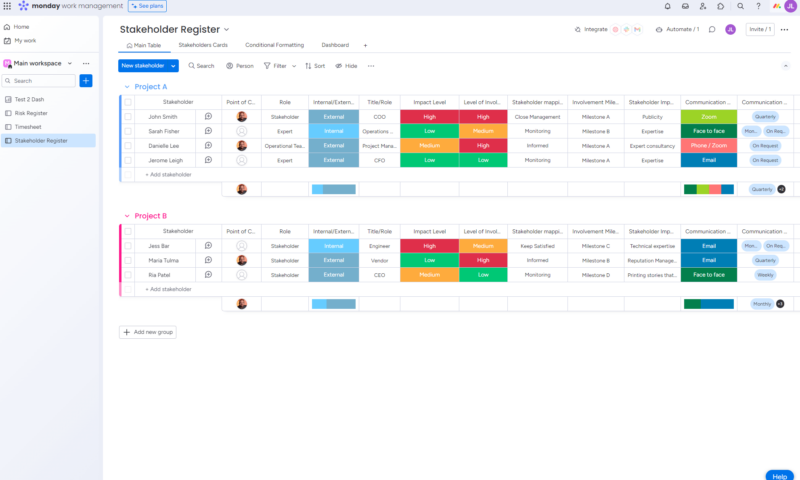
monitor tasks and other project elements.
As you can see in the image above, a board on monday.com resembles a spreadsheet that you’ll find in Excel or Google Sheets. Each column holds data like names, tasks, assigned team members, comments, statuses and more. The boards are customizable, so you can color-code and sort them to your liking.
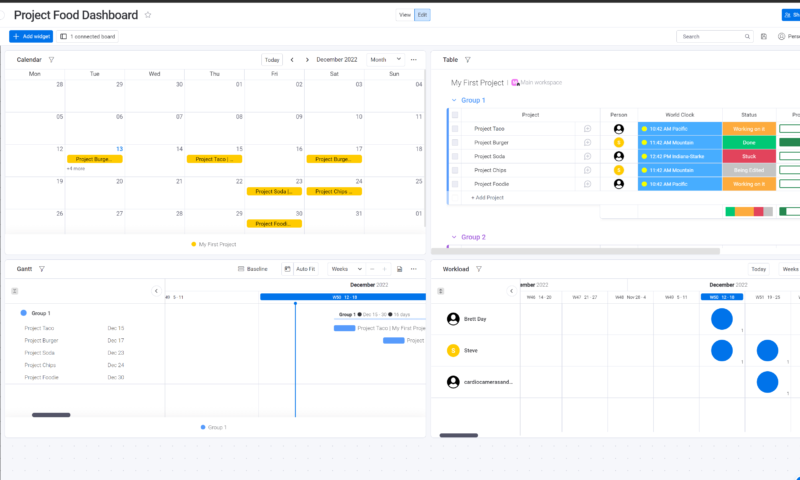
The dashboard above is just one example of how a project manager can display project information. Dashboards let you view multiple segments of project data — like kanban boards, calendars, timelines and even project finance data — in one place, making them an invaluable project management tool.
monday.com Board vs Project
The difference between a board and a project on monday.com is that a board is a place to enter, track and manage tasks relating to a project, while a project comprises a series of tasks and goals that your project team works on.
How to Create monday.com Boards
Creating boards on monday.com is easier than you think. Thankfully, monday.com’s free plan allows you to create boards for multiple projects (up to three). In this section, we’ll create a new board for a project from scratch and detail the steps so you can follow along, even if you only have the free plan.
- Create a New Board
From the left-hand menu, click the blue plus sign. When the pop-out menu appears, select “board” and then “new board.”
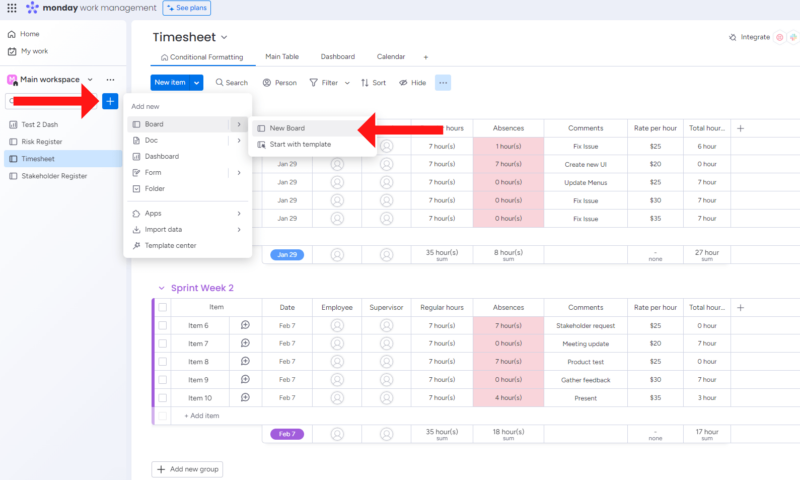
- Choose a Board Structure
Next, you must enter a board description (name). Choose whether you want the board to be main, private or shareable, and select what type of data the board will manage. You can choose from popular options like tasks, campaigns, budgets and more, or you can enter a custom data type. For this example, we’ll select “campaigns.” Now click “create board.”
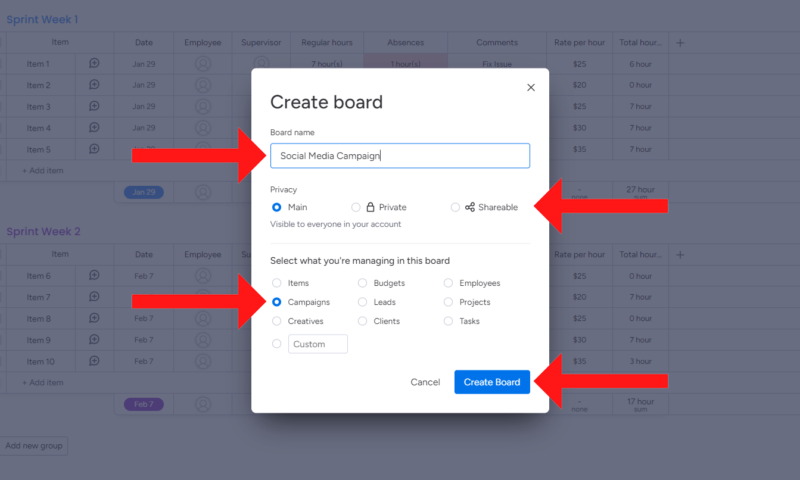
- Organize Your Board
Congrats, you’ve just created a board. Now, you’ll need to set up the board to suit your needs. The board will have some predetermined columns, which you can rename, duplicate or delete by clicking the three-dot menu located in that column (you’ll see it when you hover the mouse over the top bar of the column).
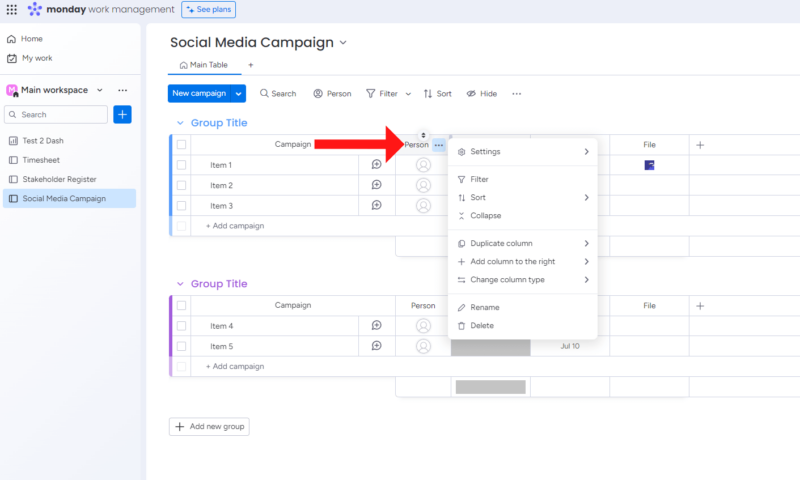
- Add Board Columns as Needed
If the board doesn’t have enough columns, you can add more. Simply click the plus sign on the right side of the board (which changes to an “X” when selected) and choose which type of column you’d like to add. If you still don’t see what you need, click the “more columns” button at the bottom of the menu.
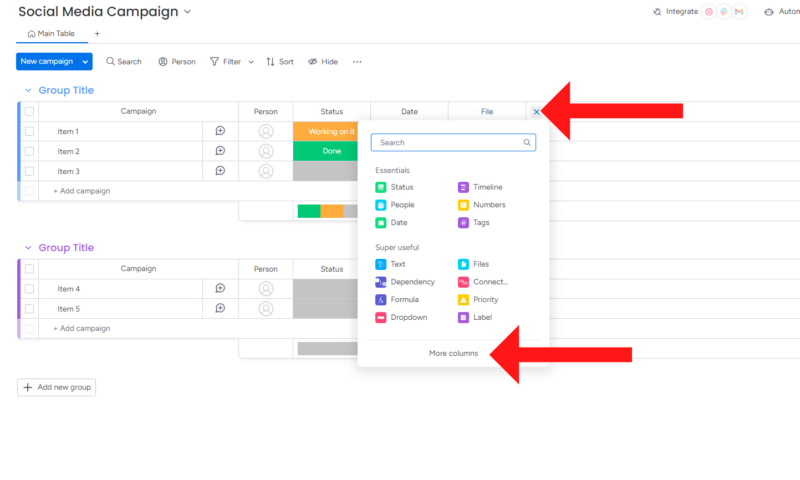
- Enter the Pertinent Information
Now that you have the board structured to your liking, you can start entering data. Simply click within each column to add data. Based on the board type and the columns you chose previously, this data can range from team members, task names, due dates, uploaded files, task statuses, dependencies and more.
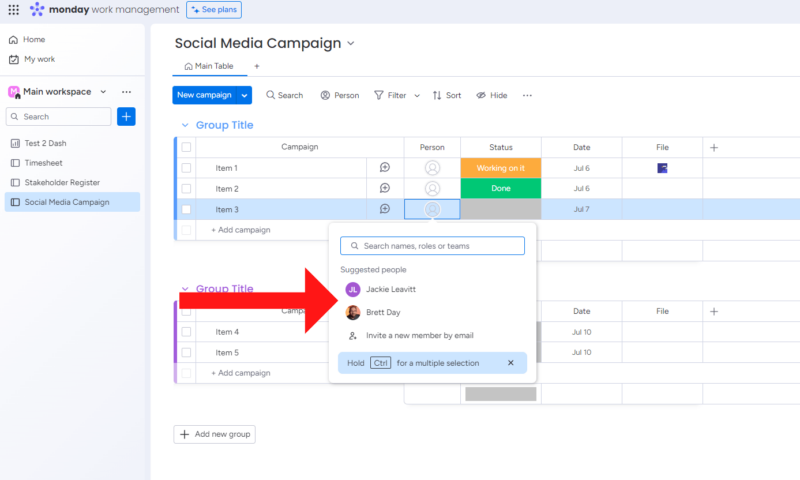
- Sort Your Data
Once you’ve entered all of your data, you can quickly sort it. To do so, hover your mouse over the column to be sorted and click the three-dot menu. Next, hover the cursor over “sort” and click “sort column.” Once that’s done, you can sort the data by ascending or descending methods.
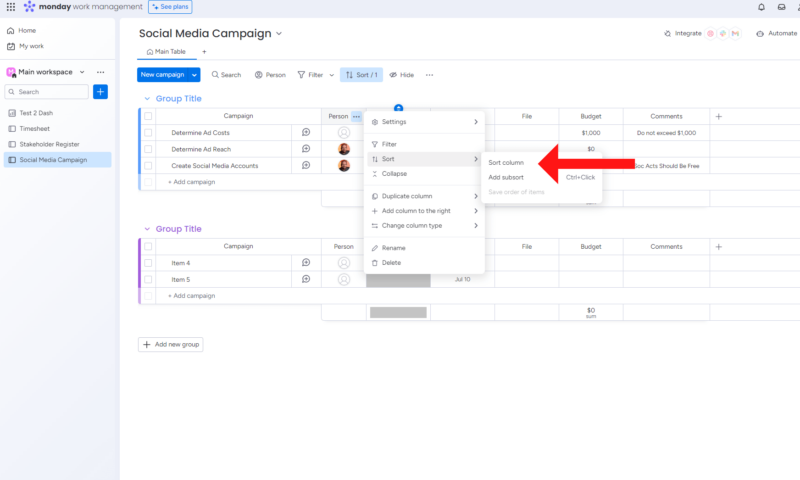
- Filter the Data as Needed
In addition to sorting, you can also filter data, which is helpful when you have large boards. Click the three-dot menu located in a column you wish to filter. Then, click “filter” and enter the filter parameters. After that, your data will be instantly filtered.
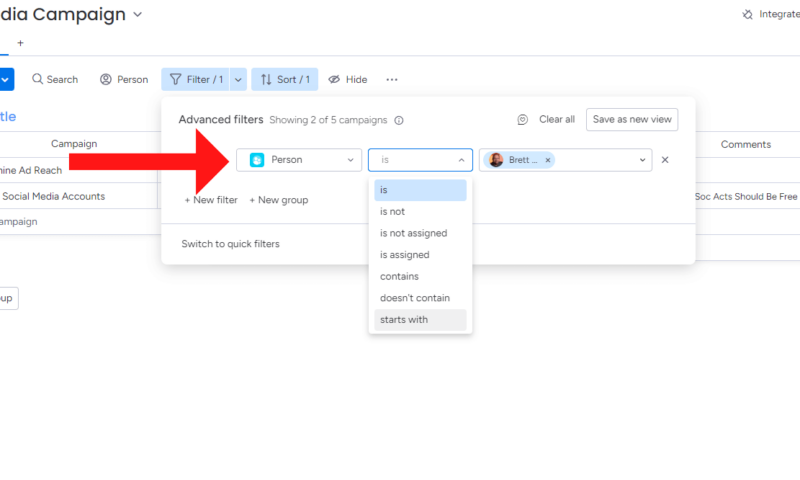
- Delete or Archive Your Board (If Desired)
If you need to delete or archive a board for any reason, you can do so easily. In the left-hand menu, hover your mouse cursor over the board’s name and click the three dots. Next, select “delete” or “archive.” Deleting the board will remove it from your account, while archiving it will remove the board from your workspace (but it can be added back later).
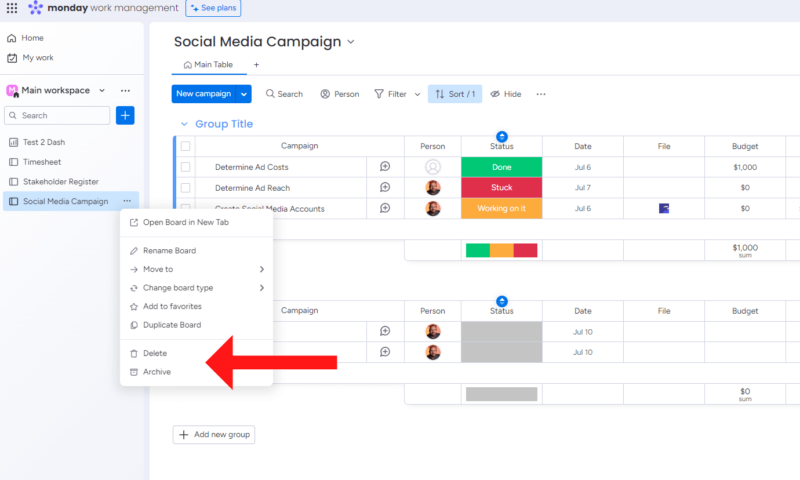
{“@context”:”https:\/\/schema.org”,”@type”:”HowTo”,”name”:”How to Create monday.com Boards”,”description”:”These steps show to to create and setup a monday.com board”,”totalTime”:”P00D04M00S”,”supply”:0,”tool”:0,”url”:”https:\/\/www.cloudwards.net\/monday-board\/#how-to-create-monday-com-boards”,”image”:{“@type”:”ImageObject”,”inLanguage”:”en-US”,”url”:”https:\/\/www.cloudwards.net\/wp-content\/uploads\/2024\/07\/How-to-Use-monday.com-Boards.png”},”step”:[{“@type”:”HowToStep”,”name”:”Create a New Board”,”position”:1,”url”:”https:\/\/www.cloudwards.net\/monday-board\/#create-a-new-board”,”itemListElement”:{“@type”:”HowToDirection”,”text”:”From the left-hand menu, click the blue plus sign. When the pop-out menu appears, select \u201cboard\u201d and then \u201cnew board.\u201d\n”},”image”:{“@type”:”ImageObject”,”inLanguage”:”en-US”,”url”:”https:\/\/www.cloudwards.net\/wp-content\/uploads\/2024\/07\/create-new-board.png”}},{“@type”:”HowToStep”,”name”:”Choose a Board Structure”,”position”:2,”url”:”https:\/\/www.cloudwards.net\/monday-board\/#choose-a-board-structure”,”itemListElement”:{“@type”:”HowToDirection”,”text”:”Next, you must enter a board description (name). Choose whether you want the board to be main, private or shareable, and select what type of data the board will manage. You can choose from popular options like tasks, campaigns, budgets and more, or you can enter a custom data type. For this example, we\u2019ll select \u201ccampaigns.\u201d Now click \u201ccreate board.\u201d\n”},”image”:{“@type”:”ImageObject”,”inLanguage”:”en-US”,”url”:”https:\/\/www.cloudwards.net\/wp-content\/uploads\/2024\/07\/board-structure.png”}},{“@type”:”HowToStep”,”name”:”Organize Your Board”,”position”:3,”url”:”https:\/\/www.cloudwards.net\/monday-board\/#organize-your-board”,”itemListElement”:{“@type”:”HowToDirection”,”text”:”Congrats, you\u2019ve just created a board. Now, you\u2019ll need to set up the board to suit your needs. The board will have some predetermined columns, which you can rename, duplicate or delete by clicking the three-dot menu located in that column (you\u2019ll see it when you hover the mouse over the top bar of the column).\n”},”image”:{“@type”:”ImageObject”,”inLanguage”:”en-US”,”url”:”https:\/\/www.cloudwards.net\/wp-content\/uploads\/2024\/07\/organize-board.png”}},{“@type”:”HowToStep”,”name”:”Add Board Columns as Needed”,”position”:4,”url”:”https:\/\/www.cloudwards.net\/monday-board\/#add-board-columns-as-needed”,”itemListElement”:{“@type”:”HowToDirection”,”text”:”If the board doesn\u2019t have enough columns, you can add more. Simply click the plus sign on the right side of the board (which changes to an \u201cX\u201d when selected) and choose which type of column you\u2019d like to add. If you still don\u2019t see what you need, click the \u201cmore columns\u201d button at the bottom of the menu.\n”},”image”:{“@type”:”ImageObject”,”inLanguage”:”en-US”,”url”:”https:\/\/www.cloudwards.net\/wp-content\/uploads\/2024\/07\/more-columns.png”}},{“@type”:”HowToStep”,”name”:”Enter the Pertinent Information”,”position”:5,”url”:”https:\/\/www.cloudwards.net\/monday-board\/#enter-the-pertinent-information”,”itemListElement”:{“@type”:”HowToDirection”,”text”:”Now that you have the board structured to your liking, you can start entering data. Simply click within each column to add data. Based on the board type and the columns you chose previously, this data can range from team members, task names, due dates, uploaded files, task statuses, dependencies and more.\n”},”image”:{“@type”:”ImageObject”,”inLanguage”:”en-US”,”url”:”https:\/\/www.cloudwards.net\/wp-content\/uploads\/2024\/07\/board-data-entry.png”}},{“@type”:”HowToStep”,”name”:”Sort Your Data”,”position”:6,”url”:”https:\/\/www.cloudwards.net\/monday-board\/#sort-your-data”,”itemListElement”:{“@type”:”HowToDirection”,”text”:”Once you\u2019ve entered all of your data, you can quickly sort it. To do so, hover your mouse over the column to be sorted and click the three-dot menu. Next, hover the cursor over \u201csort\u201d and click \u201csort column.\u201d Once that\u2019s done, you can sort the data by ascending or descending methods.\n”},”image”:{“@type”:”ImageObject”,”inLanguage”:”en-US”,”url”:”https:\/\/www.cloudwards.net\/wp-content\/uploads\/2024\/07\/sort-column.png”}},{“@type”:”HowToStep”,”name”:”Filter the Data as Needed”,”position”:7,”url”:”https:\/\/www.cloudwards.net\/monday-board\/#filter-the-data-as-needed”,”itemListElement”:{“@type”:”HowToDirection”,”text”:”In addition to sorting, you can also filter data, which is helpful when you have large boards. Click the three-dot menu located in a column you wish to filter. Then, click \u201cfilter\u201d and enter the filter parameters. After that, your data will be instantly filtered.\n”},”image”:{“@type”:”ImageObject”,”inLanguage”:”en-US”,”url”:”https:\/\/www.cloudwards.net\/wp-content\/uploads\/2024\/07\/board-filter.png”}},{“@type”:”HowToStep”,”name”:”Delete or Archive Your Board (If Desired)”,”position”:8,”url”:”https:\/\/www.cloudwards.net\/monday-board\/#delete-or-archive-your-board-if-desired”,”itemListElement”:{“@type”:”HowToDirection”,”text”:”If you need to delete or archive a board for any reason, you can do so easily. In the left-hand menu, hover your mouse cursor over the board\u2019s name and click the three dots. Next, select \u201cdelete\u201d or \u201carchive.\u201d Deleting the board will remove it from your account, while archiving it will remove the board from your workspace (but it can be added back later).\n”},”image”:{“@type”:”ImageObject”,”inLanguage”:”en-US”,”url”:”https:\/\/www.cloudwards.net\/wp-content\/uploads\/2024\/07\/delete-board.png”}}]}
What Is a Board Owner?
A board owner is a power user or a team member who can perform actions on the board that other team members cannot. For example, a board owner can add or delete columns, change assignments and more. The board owner starts as the person who created the board, but more owners can be added. Most boards will typically have only one or two board owners.
What Are monday.com Board Types?
There are three different board types on monday.com: main boards, shareable boards and private boards. Below, we’ll discuss each type so that you can better understand it.
How to Change monday.com Board Type
In this section, we’ll show you how to change the board type to ensure that the appropriate people have access to it and that privacy is available when you need it.
- Select the Board Settings
Changing the board type is straightforward. Click the three-dot menu located at the top-right corner of your monday.com screen and hover your mouse over “settings.” From the additional menu that appears, hover your cursor over “change board type.”
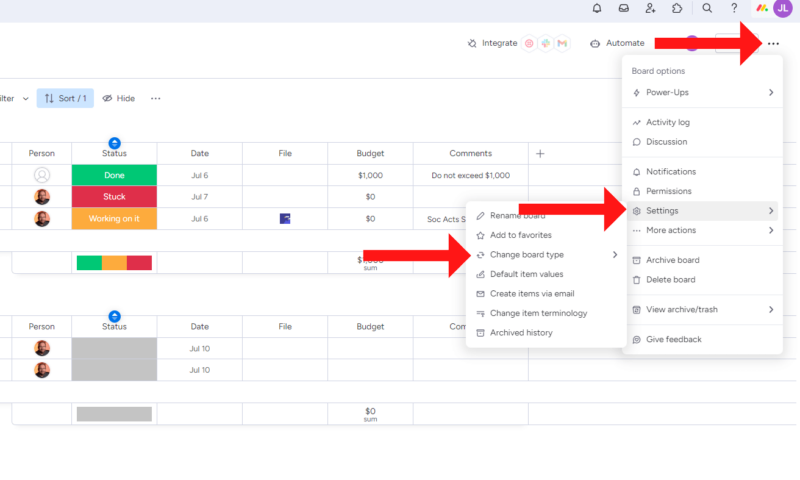
- Choose the Board Type
Next, simply choose the type of board you want to use going forward. If the board is currently a main board, you can pick between “shareable” or “private.” These options will change depending on your current board type.
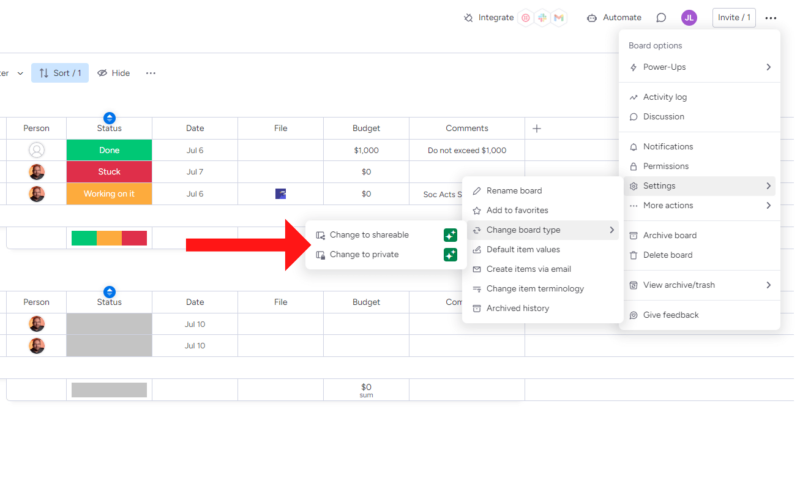
How to Adjust monday.com Board Permissions
In addition to setting board types, you can also configure the board permissions. These allow the board owner to restrict what board data other team members can change. Here are the steps for setting the board permissions.
- Choose the Board Settings
Click the three-dot menu at the top-right corner of your monday.com screen, and then click the “permissions” option.
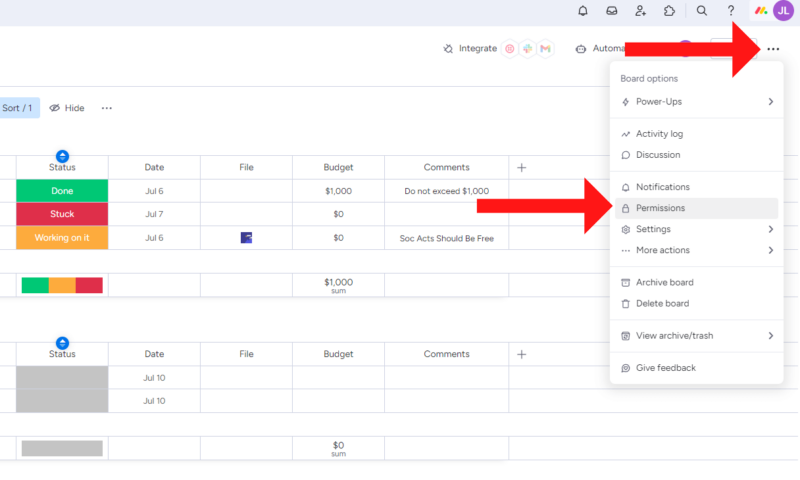
- Choose Your Desired Permissions
In the next menu that appears, select the permissions you wish to grant by reading the options and clicking the radio buttons beside them. When you’re satisfied with your selections, click “save.”
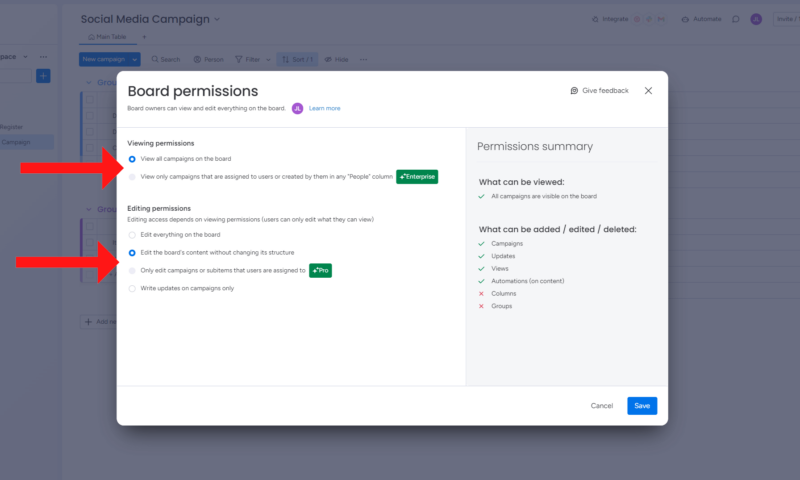
How to Share a monday.com Board
If you opt to use shareable or private boards, you’ll need to share them with specific team members. In this section, we’ll show you the steps to share boards.
- Enter the Board Settings
To change your board type, you’ll need to head to the board settings. Click the three dots in the upper-right corner to open the board menu.
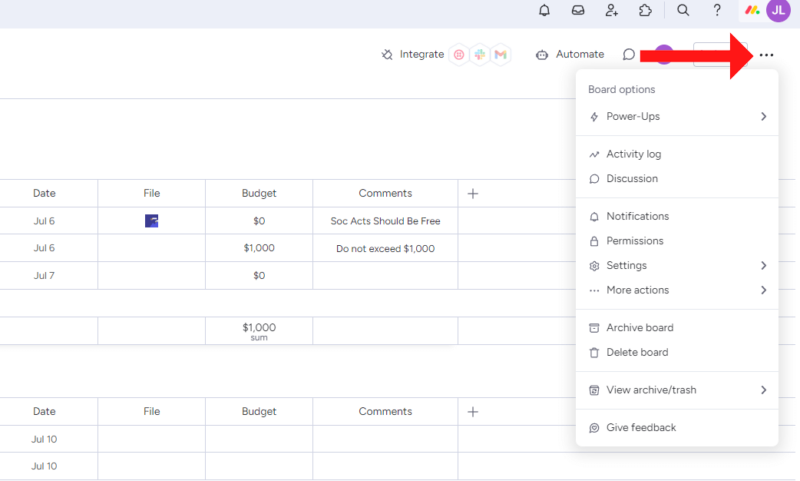
- Change the Board Type
Next, hover your mouse cursor over the “settings” option and select “change board type.” From here, you can select “change to shareable” or “change to private.” We’ll choose “change to shareable.”
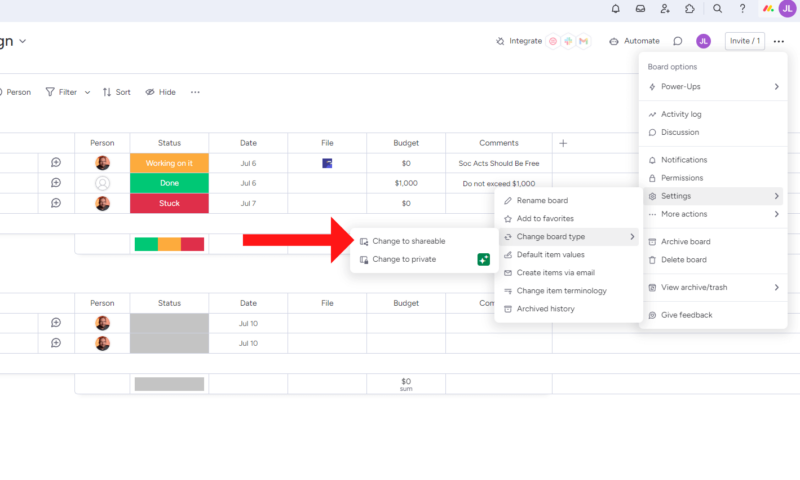
- Choose the Invite Options
A window will appear for selecting the invite options once you click the “change to shareable” button. You’ll have two options: invite them and grant them access to this board or don’t invite them and remove their access to this board (“them” applies to those who already had board access). We’ll choose the first option.
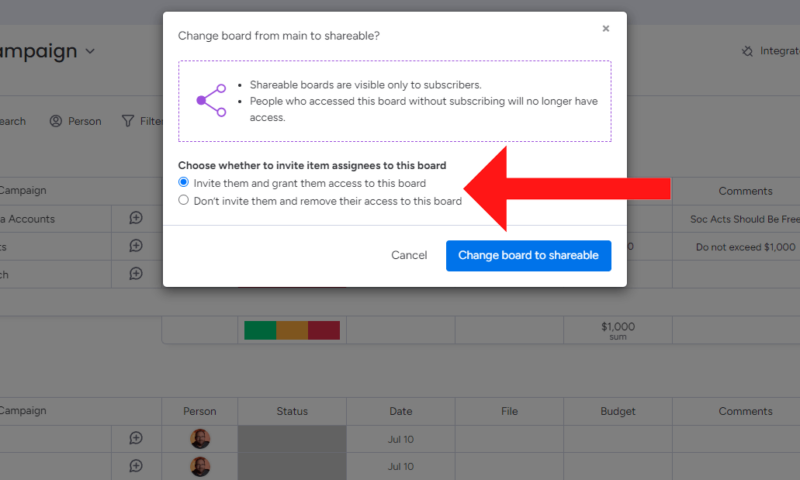
- Invite More Guests and Contributors
Now that your board is shareable, you can invite more guests and contributors. To do this, click the “invite” button at the top-right corner of the board.
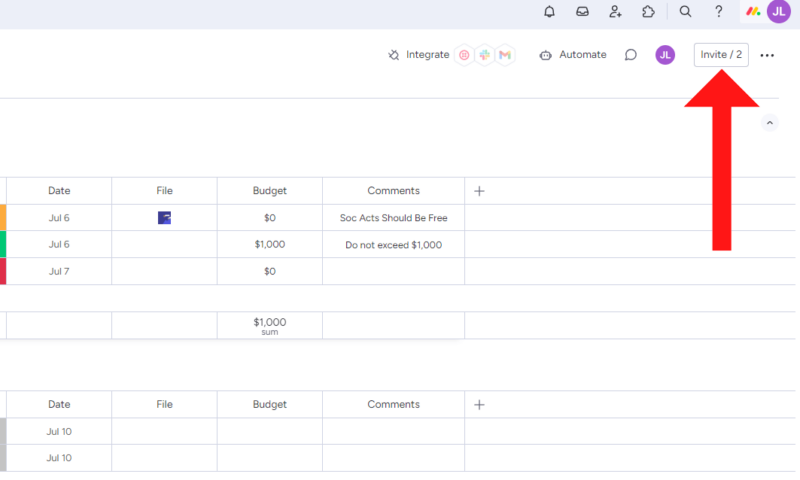
- Enter the Names or Email Addresses
Using the box that appears, you can invite colleagues, clients and external stakeholders. Invites to colleagues should be entered in the left-hand box. To invite external guests or collaborators, use the right-hand box. Once these details are entered, click the “invite a new guest by email” button.
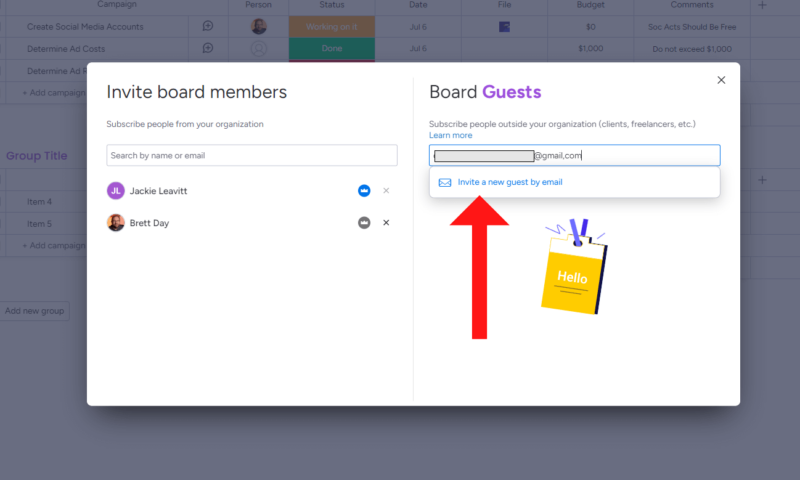
How to Duplicate a Board in monday.com
Duplicating a monday.com board is incredibly easy. In this section, we’ll list all the steps you must follow to copy boards.
- Choose the Duplication Options
Next, you’ll need to decide whether to keep the current board name or rename it. You must also choose what to duplicate: the board structure only, the board structure and items, or the board structure, items and updates.
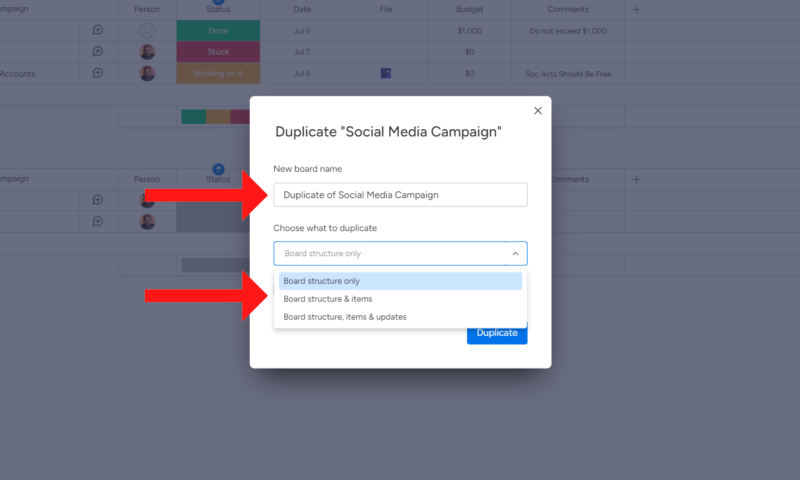
- Duplicate the Board
Next, check the bottom box if you want to add all of the current board subscribers. Leave the checkbox blank if you don’t want to add current members. Once you have made your selections, simply click the “duplicate” button to duplicate the board. The duplicated board will appear in the main left-hand navigation window.
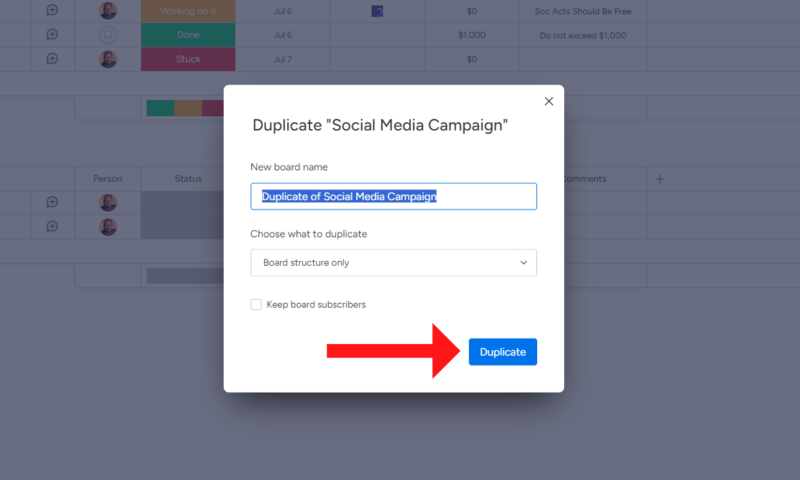
How to Track Changes and Actions on a monday.com Board
As a board owner, it’s wise to periodically check what changes have been made to your board and who made them. Below, we’ll show you the steps you’ll need to follow to track changes and actions.
How to Export monday.com to Excel
As mentioned earlier, monday.com’s boards are similar to the spreadsheets found in programs like Excel. As such, you can export data from your boards to Excel for more advanced sorting. Follow the steps below if you want to export your board data to Excel.
- Access the Main Board Options
Enter the main board options by clicking the three dots in your board’s top-right corner. Next, hover your mouse cursor over “more actions.”
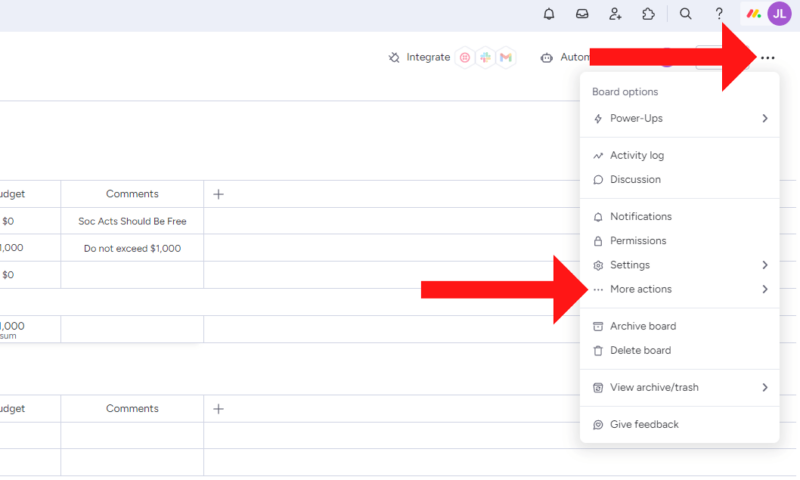
- Export the Board to Excel
Next, select the “export board to Excel” option. This will open another menu where you can make some export selections.
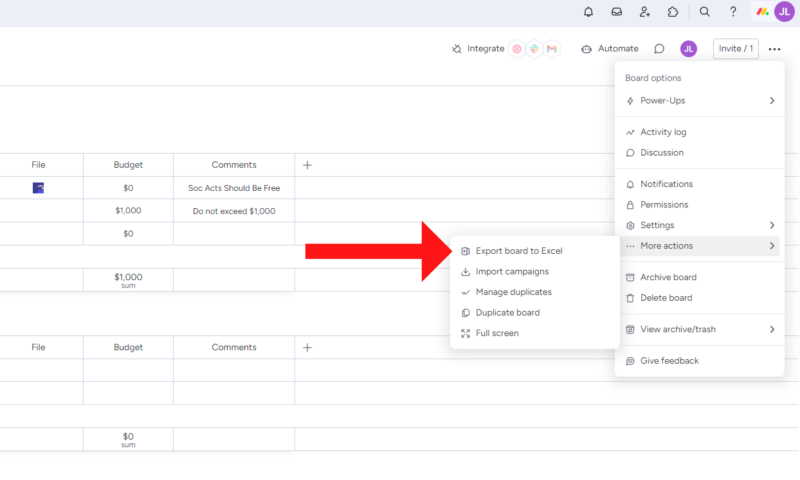
- Choose Which Data to Export
In the pop-up window, you’ll see three checkboxes: include updates, include subitems and send a copy to my email. Simply check the options you want to apply to the exported file and click “export.” An XLS file will be downloaded to your computer, which you can then import into Excel.
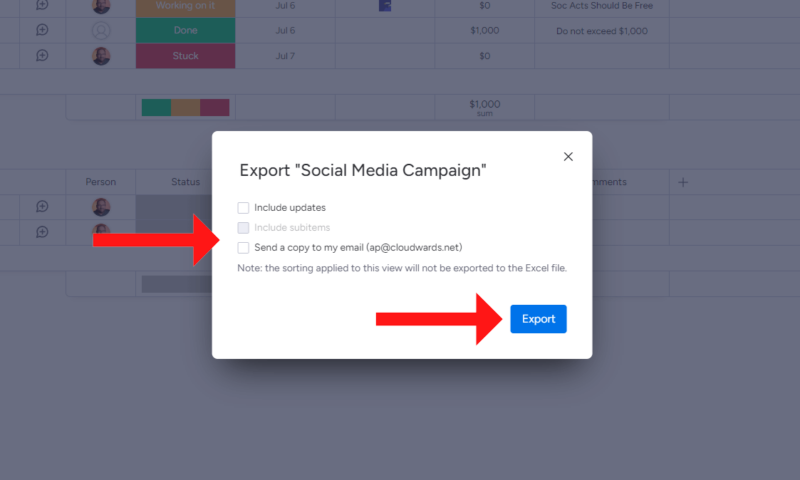
Final Thoughts
As you can see from this guide, creating, configuring, sharing and exporting monday.com boards is hassle-free. You can quickly create boards to help keep all of your team members, clients and external stakeholders on the same page. If you don’t want to create boards from scratch for items like RACI charts, remember that monday.com offers board templates.
Do you use monday.com boards to navigate projects successfully? Do you prefer to create boards, or do you like using templates? Will you try monday.com to create boards now that you’ve seen how easy it is? Let us know in the comments. Thanks for reading.
FAQ: Monday Boards
-
A monday board is a place where project managers can list project tasks and processes, as well as collaborate with team members, clients and stakeholders.
-
You can organize monday.com boards by adding or removing columns for data, sorting data or filtering data, which is especially useful for large boards.
-
You can start a monday board by clicking the blue plus sign, which is located in monday.com’s main left-hand navigation menu.
-
monday.com provides project managers with kanban boards to track and monitor project tasks efficiently.
{“@context”:”https:\/\/schema.org”,”@type”:”FAQPage”,”mainEntity”:[{“@type”:”Question”,”name”:”What Is a Monday Board?”,”acceptedAnswer”:{“@type”:”Answer”,”text”:”
A monday board is a place where project managers can list project tasks and processes, as well as collaborate with team members, clients and stakeholders.\n”}},{“@type”:”Question”,”name”:” How Do You Organize a Monday Board?”,”acceptedAnswer”:{“@type”:”Answer”,”text”:”
You can organize monday.com boards by adding or removing columns for data, sorting data or filtering data, which is especially useful for large boards.\n”}},{“@type”:”Question”,”name”:” How Do You Start a Monday Board?”,”acceptedAnswer”:{“@type”:”Answer”,”text”:”
You can start a monday board by clicking the blue plus sign, which is located in monday.com\u2019s main left-hand navigation menu.\n
\n”}},{“@type”:”Question”,”name”:”Is Monday a Kanban Board?”,”acceptedAnswer”:{“@type”:”Answer”,”text”:”
monday.com provides project managers with kanban boards to track and monitor project tasks efficiently.\n”}}]}
The post How to Use monday.com Boards: A Complete Monday Board Guide in 2024 appeared first on Cloudwards.

